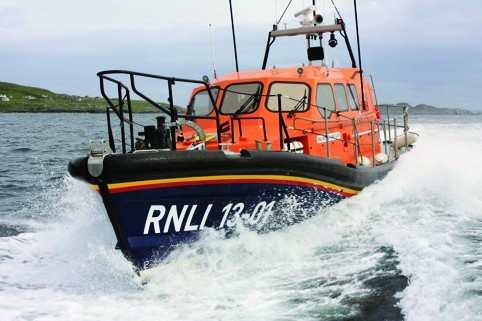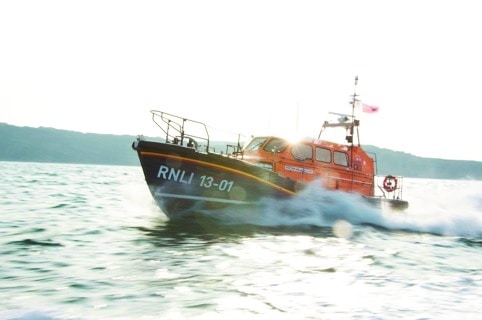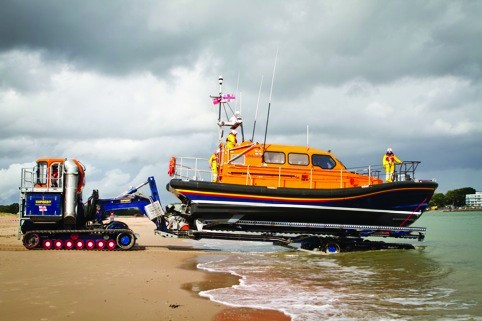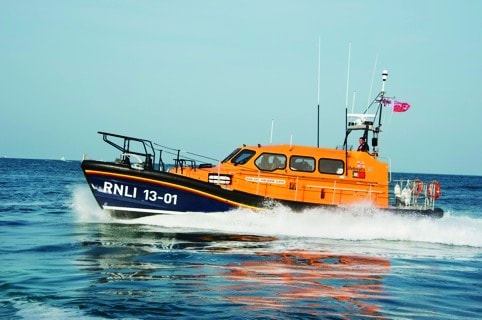Its eye-catching boathouses and distinctive blue-and-orange vessels are part of the landscape of the British seaside — a reassuring backdrop to many a summer holiday. And yet while the RNLI is almost certainly one of Britain’s best-loved charities, it’s probably fair to say that few of us actually appreciate the organisation’s scope.

It operates 500 boats from 237 lifeboat stations dotted around Britain’s rocky coastline. It designs, builds and maintains its own vessels. And while its crews are largely made up of volunteers, it employs a host of engineers and naval architects charged with maintaining and updating a fleet that has to cope with some of the toughest conditions in the ocean.
With recent weather providing a timely reminder of just how tough these conditions can be, the RNLI is going through a particularly exciting phase: the production and roll-out of the Shannon Class, its most advanced ever all-weather lifeboat.

Designed to replace the Mersey-class lifeboat, the Shannon Class is arguably one of the charity’s most ambitious projects. Many aspects of its design represent a radical step forward, and the production run of 50 vessels is the largest single run in the RNLI’s history.
A prototype began sea trials around 18 months ago, and the first vessel will be delivered to Dungeness lifeboat station in February. Six other boats are currently at various stages of construction at the Berthon Boatyard and the RNLI-owned company SAR Composites, both of which are based in Lymington on the UK’s south coast.
Steve Austen, the RNLI’s head of engineering support, explained that the vessel has been designed to meet a number of demanding operational requirements.
It has to be capable of 25kts; it must be able to right itself if it capsizes; it must be able to operate for up to 10 hours in the worst conditions the sea can throw at it; and it has got to last for 50 years. ‘Everything we do — from the design of the hull through to the seating and even down to how the windscreen wipers are attached — is on the assumption that it’ll go out into that 16m sea and will come back,’ said Austen. It has also been designed with the limitations of a volunteer crew in mind. ‘Fewer than 10 per cent have any kind of maritime background,’ he added. ‘You have to make sure you take that into account so that the boat is as intuitive as possible to use.’
In technology terms, perhaps the most original feature is the use of twin water jets to power the boat. Chosen because of the need to operate the boat in shallower water, the jets also make the boat faster and more manoeuvrable than propeller-powered vessels.
Peter Eyre, senior engineer on the Shannon Class project, explained that the improved performance stems from the moveable ‘buckets’ that alter the direction of each of the water jets and thus change the direction of the boat.
The advantage over conventional propulsion systems is that the boat can be held in a neutral position regardless of the throttle settings. And by changing the positions of the buckets — and therefore the direction of the water jets — it can perform a range of manoeuvres that would put impossible strain on conventional systems. ‘You can turn the boat on the spot, move it sideways,
stop instantaneously from flat out,’ said Eyre. ‘You’ve got ultimate control.’
Another reason for choosing the water jets is that, like the boat it’s designed to replace, the Shannon will be launched from a carriage and the profile of the jets is ideal for this approach. As previously reported, Austen’s team has worked alongside engineers from Devon engineering company Supacat on the development of an advanced submersible tractor-borne carriage system that enables the boat to be launched more quickly than its carriage-launched forbears.

Another key technology is the Systems and Information Management System (SIMS) used to control the boat. Originally developed for the Tamar class all-weather lifeboat (which was launched in 2006) this system enables crew to monitor, control and operate many of the boat’s key systems without leaving their seats. The seats themselves have also been specially designed, and equipped with a suspension system that helps the crew deal with the huge vertical slamming forces experienced in heavy seas.
But while all of these innovations make important contributions to the boat’s safety and performance, the Shannon’s bespoke hull shape is arguably its most decisive feature.
After ruling out an off-the-shelf hull early in the project, Peter Eyre, the engineer responsible for the hull, set about developing a design that was carefully optimised to reduce the risk of both vertical and sideways slamming forces.
It was, he explained, a difficult balancing act. Features such as a steeply angled bow that helps reduce vertical slamming can affect the stability and increase the risk of rolling and sideways slamming forces. And while this is a problem on all boats, it was compounded on the Shannon due to its unconventional propulsion system and lower displacement.
The resulting hull features a narrow bow designed to cut through the water which is counteracted by very wide aft sections that help keep the boat steady and upright. Severe slamming is further limited by steeper hull sections midway between the bow and the stern.
Eyre’s design was settled on following testing of a 1/8-scale model in Chichester harbour. At this stage, a number of other existing designs were still in the running. But the results, said Eyre, were surprising and persuasive: the new hull cut through the waves beautifully while remaining stable in rough conditions. He added: ‘When the results came out I thought… bloody hell — we’ve seen a dramatic improvement.’
Back on dry land, there’s been considerable innovation in the design and manufacturing processes, with an emphasis on upfront detailed design helping to shorten the project’s timescale.
‘Historically we’ve gone from concept design to prototype and then prototype to pre-production model,’ said Austen. ‘But with this one we tried to put a lot more emphasis on detailed design so that the prototype was much closer to the production standard — we’ve effectively missed out a whole stage by doing that.’
Production itself follows a lean process, with two-month tack times and a series of six separate slots for different build states.
A number of key innovations have helped to streamline this process, explained Austen. For instance, the wheelhouse and hull are kept separate for as long as possible, enabling more engineers to work on the boat. The team has also figured out an improved way of eventually joining these two sections together, using a bonded joint rather than lots of over-laminating.

The design and production strategy has been heavily influenced by the scale of the job. With 50 boats being built in one go, this is the RNLI’s biggest ever production run and there has, said Austen, been great investment and attention to detail. ‘All the time the guys have had in mind that 50-boat production run so have taken time to invest in jigs, tooling and production methods from the word go rather than thinking about it in small batches.’
The fact that the RNLI is its own customer has also had a huge bearing on the process. There’s simply no point trying to cut corners, said Austen. ‘If you can see the 50-year through-life cost it puts you in a much better position to say “it might cost me an extra £10,000 to build but I’m going to save £100,000 over the next five years by doing this”. It really does give you the design freedom to make those changes and get the benefit.’




Glasgow trial explores AR cues for autonomous road safety
They've ploughed into a few vulnerable road users in the past. Making that less likely will make it spectacularly easy to stop the traffic for...